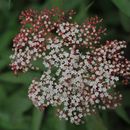en
names in breadcrumbs


Flowering from April to May; fruiting from August to September.
Sambucus javanica is close relative of Sambucus adnata, but differs from the latter in its non-red (vs. red) roots, with staminate and pistillate (vs. without staminate and pistillate) flowers.
Sambucus javanica is occurring Anhui, Fujian, Gansu, Guangdong, Guangxi, Guizhou, Hainan, Henan, Hubei, Hunan, Jiangsu, Jiangxi, Shaanxi, Sichuan, Taiwan, Xizang, Yunnan, Zhejiang of China, Cambodia, India, Indonesia, Japan, Laos, Malaysia, Myanmar, Philippines, Thailand, Vietnam.
Phylogeny of Sambucus were inferred from nucleotide sequences of the internal transcribed spacer (ITS) region of nuclear ribosomal DNA, preliminary morphology, and a combination of the two data sets (Eriksson and Donoghue, 1997). Monophyly of Sambucus was strong supported based on ITS sequences and in the combined analysis. Within Sambucus, species with paniculate inflorescences (sect. Botryosambucus) form a well-supported clade, within which the red-fruited species are monophyletic. These results support the view that paniculate inflorescences and red fruits evolved independently in Sambucus and Viburnum.
Herbs, suffrutescent, or low shrubs, 1-2 m tall. Stem obviously striate; pith white; lenticels inconspicuous. Leaves imparipinnate; stipules leaflike or sometimes reduced to blue glands; lateral leaflets 2-3-pairs, alternate or opposite, narrowly ovate, 5-15 cm long, 2-5 cm wide, adaxially sparsely pubescent when young, base obtuse and oblique, margin serrulate, often with several glandular teeth from below middle nearly to base, apex long acuminate; terminal leaflet ovate or obovate, base cuneate, sometimes connected with next lower leaflets, basal pair of leaflets shortly petiolulate; stipules of leaflets absent. Inflorescences terminal, compound umbellate cymes, lax, pedunculate, with leaflike bracts at base of peduncle, with 3-6-slender rays, with sparse yellow pubescence. Some flowers modified into persistent urceolate nectaries. Calyx tube urceolate, lobes triangular; corolla white, connate at base. Anthers yellow or purple. Ovary locules 3, styles short or nearly absent; stigma 3-lobed. Fruit red, nearly globose; pyrenes 3-4, ovoid, verrucate.
Growing in mountain slopes,forest,streamsides, grasslands; 500-2500 m.
Sambucus javanica is defined by its abundant extrafloral nectaries on the petioles, branchlets, young stems, peduncle, and inflorescence branches.
Sambucus javanica, the Chinese elder, is a species of elderberry in the family Viburnaceae native to subtropical and tropical Asia. It is found naturally in Bhutan, Burma, Cambodia, China (except in the north), India, Indonesia, Japan, Laos, Malaysia (in Sabah), the Philippines, southern Thailand, and Vietnam.[4][3] It is a perennial herb or a small shrub 1–2 m (3 ft 3 in – 6 ft 7 in) tall.[4]
Parts of the plant are used locally, variously as analgesics, blood purifiers, bowel and bladder stimulants, or even for poison.[5] It is also believed to be an aid against numbness, rheumatism, spasms, swelling, and trauma, as well as for general bone and circulatory health.[5]
Sambucus javanica, the Chinese elder, is a species of elderberry in the family Viburnaceae native to subtropical and tropical Asia. It is found naturally in Bhutan, Burma, Cambodia, China (except in the north), India, Indonesia, Japan, Laos, Malaysia (in Sabah), the Philippines, southern Thailand, and Vietnam. It is a perennial herb or a small shrub 1–2 m (3 ft 3 in – 6 ft 7 in) tall.
Parts of the plant are used locally, variously as analgesics, blood purifiers, bowel and bladder stimulants, or even for poison. It is also believed to be an aid against numbness, rheumatism, spasms, swelling, and trauma, as well as for general bone and circulatory health.

Leaves and phyllotaxy

Terminal inflorescence.

Yellow nectaries.

Flower, macro photography.